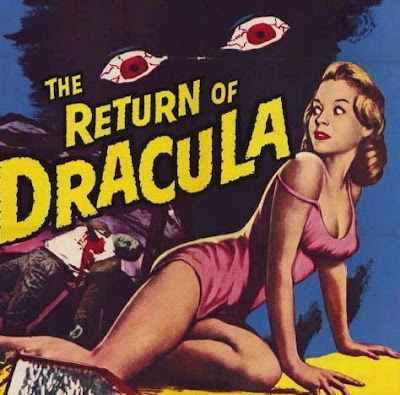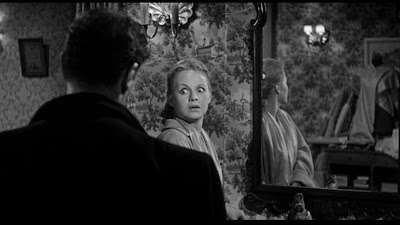While Lugosi's turns as Dracula don't rank among my favorite of his performances, Dracula is the character he is most famous for playing, despite the fact he only portrayed the character twice--once at the beginning of his film career and once at during its twilight. This post covers both of them.
Dracula (1931)
Starring: Bela Lugosi, Dwight Frye, Helen Chandler, Edward Van Sloan, Herbert Bunston, David Manners, and Charles K. Gerrard
Director: Tod Browning
Rating: Seven of Ten Stars
Count Dracula (Lugosi) travels to England where he sates his bloodlust on young women, including the lovely Mina (Chandler).
Universal's 1931 "Dracula" was the first horror talkie and is one of the three most influential horror films ever made. It's a film that's truly a significant milestone not only in film history, but in pop culture as well, and, even though its age is showing, it's a genuiine classic.

I don't think anything quite as subtly creepy and startling as Dracula passing through a mass of cobwebs without breaking them has ever been put on film. It's a perfect film moment, because the feeling of "waitaminnit... did that just happen?" that Renfield (Frye) has is shared by the audience, and we're sitting there with a chill that goes right down to our very bones.
Because this film is such a classic milestone, I feel a bit awkward about not liking it more than I do. Like "Frankenstein" (also made by Universal in 1931), this movie has nearly as many flaws as it has elements of perfection.
The biggest problem with "Dracula" is the haphazard way the film unfolds, particuarly in its second half. The vampiric Lucy and her preying on little children is dealt with a throw-away fashion, and the climactic encounter at Carfax Abby, which is so weakly and disjointedly handled that it is barely a climax at all. (It's particuarly dissapointing that Dracula's death happens entirely off-screen, except for a very effective reaction from the psychically bonded Mina.)
In fact, in many ways, it's almost as if someone forgot the movie needed a script, and it was made up as the crew went along. The film is worth seeing for spectacular performances from Bela Lugosi (it's easy to see why he solidified vampires as suave, sharp-dresserrs as opposed to fugly scarecrows like the one featured in "Nosferatu"), Dwight Frye (who, as Renfield, is as much a star of the film as Lugosi, and who does some great acting when he vascilates from raving madman to apparently sane and back again), and Helen Chandler (who, as Mina, conveys more with her eyes, body language, and facial expressions than one would thinks possible, and who has the only decent moment during the film's climax as she shares in Dracula's pain as Van Helsin stakes him). The film's impressive sets and creative camera work also bring about some genuinely creepy moments, such as when Dracula and his vampire brides emerge from their coffins under his Transylvanian castle, and then when they later close on an unconcious Renfield; the discovery of Renfield in the hold of the death ship after it runs aground; Dracula's feeding upon the flower girl in London; Renfield crawling across the floor toward an unconcious maid with a look of madness and bloodlust on his face; Mina's transformation as she urges John Harker to get rid of Van Helsing and his cruxifixes; and Dracula and Mina's arrival at Carfax Abby.
But, for every great moment or spectacular performance, there's a boring one, or one where opportunities that should have been obvious to filmmakes even in 1931 are completely missed. Edward Van Sloan (as Van Helsing) and David Manners (as a particularly milquetoasty Harker) are completely dead spots in the film, giving weak performances that almost manage to drag down those excellent ones from Chandler, Frye, and Lugosi. (In fact, Van Sloan and Manners are so weak here that it's surprising to me that they;'re the same actors who do so well in "The Mummy" just one years later. (Perhaps the better script and a different director made all the difference for them.)
By the way, the new score that Phillip Glass composed for the restored version of the film included in the "Dracula Legacy Collection" (and which can be toggled on and off) is actually a fine reflection of the movie itself: Glass has some good moments and some supremely weak moments in his score. For the most part, it is just muazak that doesn't seem to have a whole lot to do with enhancing the mood on the scrreen, but every so often, it is spot-on and it makes the film that much more impressive. (Glass's music ALMOST gives the film's climax some impact, for example.)
Although far from perfect, the 1931 "Dracula" is a must-see for anyone with an interest in examining the origins of horror as a seperate and unique genre. While I'll take "White Zombie" or "The Mummy" over this film any day, I think the 75 minutes it takes to watch this film, is time well spent.
Abbott and Costello Meet Frankenstein (1948)
Starring: Bud Abbott, Lou Costello, Lon Chaney Jr., Lenore Aubert, and Bela Lugosi
Director: Charles Barton
Rating: Eight of Ten Stars
The reluctant Wolfman, Larry Talbot (Chaney) learns that Dracula (Lugosi) intends to revive Frankenstein's Monster and use it as his personal super-soldier. He pursues the evil vampire lord to the United States where he finds his only allies to be Wilbur and Chick (Costello and Abbott), a couple of less-than-bright shipping clerks. Unfortunately, Dracula as an ally of his own--mad scientist femme fatale Dr. Sandra Mornay (Aubert), and she has Wilbur wrapped around her little finger. Little does Wilbur know that his girlfriend doesn't love him for his mind but rather his brain... she intends to do Dracula's bidding and transplant into the rejuvinated monster!

"Abott and Costello Meet Frankenstein" is a wild screwball comedy with the two master comedians doing their usual routines within the framework of a solid script and a story that's actually pretty logical in its own crazy way. I think it's the first fusion of comedy and monsters, and one reason it works so well is that the monsters are played straight. Even when they are involved in funny schtick (Dracula and the Wolf Man are both part of several routines), they remain as they were featured in the serious monster movies they were in.
Too often, I hear this film written off as Universal's last and crassest attempt to wring some dollars out of their tired monster franchise. While that may be all the studio bosses had in mind, the creators involved with "Abbott and Costello Meet Frankenstein" managed to make a great movie that is still worth watching today. It's even superior to many of Universal's "straight" movies with Dracula, Frankenstein's Monster, and the Wolf Man (or, for that matter, countless recent so-called horror films). Much of its strength grows from the fact that has a plot that with some tweaking could be a straight horror movie.
I recommend this underappreciated film to any lover of the classic monster films, as well as lovers of slapstick comedy.
















.jpg)






.jpg)
